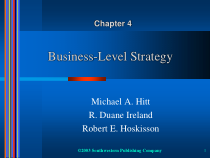 PPT
PPT
【文档说明】浅述家具行业事业层策略(英文版).pptx,共(62)页,204.791 KB,由精品优选上传
转载请保留链接:https://www.ichengzhen.cn/view-292913.html
以下为本文档部分文字说明:
Business-LevelStrategyMichaelA.HittR.DuaneIrelandRobertE.HoskissonChapter41©2003SouthwesternPublishingCompanyStrategyImpl
ementationChapter11OrganizationalStructureandControlsChapter10CorporateGovernanceChapter12StrategicLeadershipStrategyF
ormulationChapter4Business-LevelStrategyStrategicCompetitivenessAbove-AverageReturnsStrategicIntentStrategicMissionChapter2TheExter
nalEnvironmentChapter3TheInternalEnvironmentTheStrategicManagementProcessFeedbackStrategicInputsStrategicA
ctionsStrategicOutcomesChapter13StrategicEntrepreneurship2Business-LevelStrategyBusiness-levelstrategy:anintegratedandc
oordinatedsetofcommitmentsandactionsthefirmusestogainacompetitiveadvantagebyexploitingcorecompetenciesinspecificpr
oductmarkets3CoreCompetenciesandStrategyTheresourcesandcapabilitiesthathavebeendeterminedtobeasource
ofcompetitiveadvantageforafirmoveritsrivalsAnintegratedandcoordinatedsetofactionstakentoexploitcorecompetenciesandgainaco
mpetitiveadvantageActionstakentoprovidevaluetocustomersandgainacompetitiveadvantagebyexploitingcorecompetenciesinspecific,individualproductmarke
tsBusiness-levelstrategyStrategyCorecompetencies4KeyIssuesofBusiness-LevelStrategy⚫Whatgoodorservicetooffercustomers⚫Howtoman
ufactureorcreatethegoodorservice⚫Howtodistributethegoodorserviceinthemarketplace5TheCentralRoleofCustomersInselectingabusiness-levelstra
tegy,thefirmdetermines1.whoitwillserve2.whatneedsthosetargetcustomershavethatitwillsatisfy3.howthosen
eedswillbesatisfied6策略事業單位的確認⚫Strategicbusinessunit,SBU⚫事業競爭策略管理的單位⚫事業單位的界定–顧客群–顧客需要–核心能力7ManagingRelationshipsWithCustomers⚫Customerrel
ationshipsarestrengthenedbyofferingthemsuperiorvalue–helpcustomerstodevelopanewcompetitiveadvantage–enhancethevalueofexistingcompetitiveadvan
tages8ManagingRelationshipsWithCustomers⚫Establishacompetitiveadvantagealongthesedimensions:Reach–th
efirm’saccessandconnectiontocustomersRichness–thedepthanddetailofthetwo-wayflowofinformationbetweenthefirmandcustomersAffiliation–facilitati
ngusefulinteractionswithcustomers9顧客分析⚫企業服務的對象是誰?(WHO)⚫目標顧客想要獲得滿足是什麼?(WHAT)⚫企業如何以選定的策略滿足顧客需求?(HOW)⚫不斷重新思考顧客是誰⚫和顧客
保持密切與經常的接觸⚫決定如何利用對手無法仿效的核心能力來創造價值⚫設計合宜策略10CustomersMarketSegmentationConsumerMarketsIndustrialMarkets11企業
服務的對象是誰?(WHO)⚫區隔市場–人口統計變數–地理變數–生活型態–個人特質–消費模式–產業結構特性–組織規模⚫市場區隔中的市場區隔⚫利用資訊科技⚫大規模顧客化(masscustomerization)的效益12M
arketSegmentation:ConsumerMarketsDemographicfactorsConsumerMarketsSocioeconomicfactorsGeographicfactorsPsychologicalfactorsConsumptionpatter
nsPerceptualfactorsDem.Soc.Geo.Psy.Con.Per.13MarketSegmentation:IndustrialMarketsIndustrialMarketsEnd-usesegmentsProductsegme
ntsGeographicsegmentsCommonbuyingfactorsegmentsCustomersizesegmentsEndPro.Geo.Buy.Size14目標顧客想要什麼?(WHAT)⚫確
認與了解目標顧客的需求⚫預測目標顧客未知(發現)的需求–在顧客之前–在對手有行動之前(第一行動者優勢)⚫設法利用本身之核心能力以滿足顧客的需求15TypesofBusiness-LevelStrategies⚫Business-levelst
rategiesareintendedtocreatedifferencesbetweenthefirm’spositionrelativetothoseofitsrivals⚫Topositionitself,thefirmmustdecidewhetherit
intendstoperformactivitiesdifferentlyortoperformdifferentactivitiesascomparedtoitsrivals16競爭策略的選擇⚫在特定產業中事業單位針對所選定的市場區隔,如何以競爭策略改善其產品或服務的競爭地位,並
建立可持久的競爭優勢⚫策略選擇的考慮因素–產業長期獲利率水準與影響獲利之因素–產業中企業的相對競爭地位17FiveGenericStrategiesCompetitiveAdvantageCompetitiveScopeCostUniquenessBroadtargetNarr
owtargetCostLeadershipDifferentiationFocusedCostLeadershipFocusedDifferentiationIntegratedCostLeadership/Differenti
ation18產品/市場/核心能力/競爭策略成本領導策略差異化策略集中化策略產品差異化低(主要來自價格)高(主要來自獨特性)低至高(價格或獨特性)市場區隔化低(大市場)高(許多個區隔市場)低(一個或一些區隔市場)核心能力製造與物料管理研發/行銷任何19CostLea
dershipStrategyAnintegratedsetofactionsdesignedtoproduceordelivergoodsorservicesatthelowestcost,relativetocompetitorswithfeaturesthatareaccept
abletocustomers–relativelystandardizedproducts–featuresacceptabletomanycustomers–lowestcompetitiveprice20CostLeadershipStrategyCostsavingacti
onsrequiredbythisstrategy:–buildingefficientscalefacilities–tightlycontrollingproductioncostsandoverhead–mini
mizingcostsofsales,R&Dandservice–buildingefficientmanufacturingfacilities–monitoringcostsofactivitiesp
rovidedbyoutsiders–simplifyingproductionprocesses21HowtoObtainaCostAdvantageCostDriversValueChainDetermineandcontrolReconfigure,ifneeded•Alterproduc
tionprocess•Changeinautomation•Newdistributionchannel•Directsalesinplaceofindirectsales•Newadvertisingmed
ia•Newrawmaterial•Backwardintegration•Forwardintegration•Changelocationrelativetosuppliersorbuyers22ProductfeaturesPerforman
ceMix&varietyofproductsServicelevelsSmallvs.largebuyersProcesstechnologyWagelevelsHiring,training,motivationFactorsThatDriveCostsEconomies
ofscaleAssetutilizationCapacityutilizationpattern•Seasonal,cyclicalInterrelationshipsOrderprocessingandd
istributionValuechainlinkages•Advertising&sales•Logistics&operations23支援性活動基本活動內部後勤作業外部後勤行銷與銷售服務採購技術發展人力資源管理企業的基礎建設價值創造活動--成本領導策略組織扁平以減少間接成本簡化規劃
程序與成本降低流動率訓練員工以改善效率與效能強調製程創新與改善投資與致力於發展降低製造成本的活動改善採購程序與對供應商關係以降低進貨成本定期評估供應商績效使供應商與生產程序密切配合獲得規模經濟設置可得效率規模的生產設施降低送貨成本選擇低成本的運送人精簡銷
售人員與提高素質訂定具競爭力的價格有效率與適當安裝以降低修理率24QuestionsLeadingtoLowerCosts1.Howcananactivitybeperformeddifferentlyo
reveneliminated?2.Howcanagroupoflinkedvalueactivitiesberegroupedorreordered?3.Howmightcoalitionswithotherfirmsloweroreliminatecosts?25CostLeade
rshipStrategyandtheFiveForcesofCompetitionRivalryAmongCompetingFirmsCanusecostleadershipstrategytoadvantagesince:competitorsavo
idpricewarswithcostleaders,creatinghigherprofitsfortheentireindustryBargainingPowerofSuppliersFiveForcesofCompetition26CostLeadershipStra
tegyandtheFiveForcesofCompetitionBargainingPowerofBuyersCanmitigatebuyers’powerby:drivingpricesfarbelowcompetitors,causingthemtoexitandshiftingpowe
rwithbuyersbacktothefirmBargainingPowerofSuppliersFiveForcesofCompetition27CostLeadershipStrategyandtheFiveForces
ofCompetitionBargainingPowerofSuppliersCanmitigatesuppliers’powerby:beingabletoabsorbcostincreasesduetolowco
stpositionbeingabletomakeverylargepurchases,reducingchanceofsupplierusingpowerBargainingPowerofSuppliersFiveFo
rcesofCompetition28CostLeadershipStrategyandtheFiveForcesofCompetitionBargainingPowerofSuppliersFiveForcesofC
ompetitionThreatofNewEntrantsCanfrightenoffnewentrantsdueto:theirneedtoenteronalargescaleinordertobecostcompe
titivethetimeittakestomovedownthelearningcurve29CostLeadershipStrategyandtheFiveForcesofCompetitionThreatofSubstituteProductsCostleader
iswellpositionedto:makeinvestmentstobefirsttocreatesubstitutesbuypatentsdevelopedbypotentialsubstituteslowerpricesinordertomain
tainvaluepositionBargainingPowerofSuppliersFiveForcesofCompetition30MajorRisksofCostLeadershipStrategy⚫Dramaticte
chnologicalchangecouldtakeawayyourcostadvantage⚫Competitorsmaylearnhowtoimitatevaluechain⚫Focusonefficienc
ycouldcausecostleadertooverlookchangesincustomerpreferences31DifferentiationStrategyAnintegratedsetofactionsde
signedbyafirmtoproduceordelivergoodsorservices(atanacceptablecost)thatcustomersperceiveasbeingdifferentinwaysthatareimportanttothem–pricefor
productcanexceedwhatthefirm’stargetcustomersarewillingtopay–nonstandardizedproducts–customersvaluedifferentiatedfea
turesmorethantheyvaluelowcost32DifferentiationStrategy⚫Valueprovidedbyuniquefeaturesandvaluecharacteristics⚫Commandpremiumprice溢價⚫Highcustomers
ervice⚫Superiorquality⚫Prestigeorexclusivity⚫Rapidinnovation33DifferentiationStrategyDifferentiationactionsreq
uiredbythisstrategy:–developingnewsystemsandprocesses–shapingperceptionsthroughadvertising–qualityfocus–capabilityinR
&D–maximizehumanresourcecontributionsthroughlowturnoverandhighmotivation34HowtoObtainaDifferentiationAdvantageCostDr
iversValueChainControlifneededReconfiguretomaximizecustomerperceptionsofuniquenesscustomerreluctancetoswitchtonon-uniqueproduct•Raiseperformanceofpro
ductorservice•Lowerbuyers’costs•Createsustainabilitythrough:35FactorsThatDriveDifferentiation⚫Uniqueproductfe
atures⚫Uniqueproductperformance⚫Exceptionalservices⚫Newtechnologies⚫Qualityofinputs⚫Exceptionalskillorexperience⚫Detailedinformation36支援性活動基本活動內部後勤
作業外部後勤行銷與銷售服務採購技術發展人力資源管理企業的基礎建設價值創造活動--差異化策略經由資訊系統更了解顧客推行全面品管創新獎勵辦法強調非客觀性績效評量人員訓練注重基礎研究與產品創新發展容易取得高品質原料的系統採購高品質零件妥善處理進料以維持高品質迅速反應顧客需求生
產足以吸引顧客的產品正確與快速處理顧客訂單迅速送達貨品安排各種信用交易與顧客及供應商保持密切關係訓練顧客正確使用產品保留完整零件庫存37DifferentiationStrategyandtheFiveForcesofCompetitio
nRivalryAmongCompetingFirmsCandefendagainstcompetitionbecause:brandloyaltytodifferentiatedproductoffsetspricecompetitionBargainingPowerofSuppliersFi
veForcesofCompetition38DifferentiationStrategyandtheFiveForcesofCompetitionBargainingPowerofBuyersCanmitiga
tebuyerpowerbecause:welldifferentiatedproductsreducecustomersensitivitytopriceincreasesBargainingPowerofSuppliersFiveForcesofCompetition39Differenti
ationStrategyandtheFiveForcesofCompetitionBargainingPowerofSuppliersCanmitigatesuppliers’powerby:absorbingpriceincreases
duetohighermarginspassingalonghighersupplierpricesbecausebuyersareloyaltodifferentiatedbrandBargainingPowe
rofSuppliersFiveForcesofCompetition40DifferentiationStrategyandtheFiveForcesofCompetitionThreatofNewEntrantsCandefendagainstnewentrantsbecause:newpr
oductsmustsurpassprovenproductsor,newproductsmustbeatleastequaltoperformanceofprovenproducts,butoffereda
tlowerpricesBargainingPowerofSuppliersFiveForcesofCompetition41DifferentiationStrategyandtheFiveForcesofCompetitionThrea
tofSubstituteProductsWellpositionedrelativetosubstitutesbecause:brandloyaltytoadifferentiatedproducttendstore
ducecustomers’testingofnewproductsorswitchingbrandsBargainingPowerofSuppliersFiveForcesofCompetition42MajorRisksofDifferentiationStrate
gy⚫Customersmaydecidethatthepricedifferentialbetweenthedifferentiatedproductandthecostleader’sproductistoolarge⚫Meansofdifferentiationmayc
easetoprovidevalueforwhichcustomersarewillingtopay⚫續下頁43MajorRisksofDifferentiationStrategy⚫Experiencemaynarrowcustomer’sperceptionsoftheva
lueofdifferentiatedfeaturesofthefirm’sproducts⚫Makersofcounterfeitgoodsmayattempttoreplicatedifferentiatedfeaturesofthefirm’sproducts仿冒品44FocusedBus
iness-LevelStrategiesAfocusstrategymustexploitanarrowtarget’sdifferencesfromthebalanceoftheindustryby:–iso
latingaparticularbuyergroup–isolatingauniquesegmentofaproductline–concentratingonaparticulargeographicmarket–findingtheir“niche”45FactorsThatMayDrive
FocusedStrategies⚫Largefirmsmayoverlooksmallniches⚫Firmmaylackresourcestocompeteinthebroadermarket⚫Maybeabletoserveanar
rowmarketsegmentmoreeffectivelythancanlargerindustry-widecompetitors⚫Focusmayallowthefirmtodirectresourcestocertainvalu
echainactivitiestobuildcompetitiveadvantage46MajorRisksofFocusedStrategies⚫Firmmaybe“outfocused”bycompetitors⚫Largecompetitorma
ysetitssightsonyournichemarket⚫Preferencesofnichemarketmaychangetomatchthoseofbroadmarket47Advantagesof
IntegratedStrategyAfirmthatsuccessfullyusesanintegratedcostleadership/differentiationstrategyshouldbeinabetterpositionto:–adaptquick
lytoenvironmentalchanges–learnnewskillsandtechnologiesmorequickly–effectivelyleverageitscorecompetencieswh
ilecompetingagainstitsrivals48BenefitsofIntegratedStrategy⚫Successfulfirmsusingthisstrategyhaveabove-averagereturns⚫Firmofferstwotypesofv
aluestocustomers–somedifferentiatedfeatures(butlessthanatruedifferentiatedfirm)–relativelylowcost(butnowaslowasthecostlead
er’sprice)49MajorRisksofIntegratedStrategy⚫Anintegratedcost/differentiationbusinesslevelstrategyofteninvolvescompromis
es(neitherthelowestcostnorthemostdifferentiatedfirm)⚫Thefirmmaybecome“stuckinthemiddle”lackingthestrongcommitmen
tandexpertisethataccompaniesfirmsfollowingeitheracostleadershiporadifferentiatedstrategy50整合性低成本/差異化策略的風險企業若無法在自己所選定的競爭範疇中建立領導地位,或沒有明確的競爭優勢,便會遭遇夾
在其中的風險51HolidayInn個案⚫HolidayInn的發展]–創始人—KemmonsWilson於1950年代出外渡假時發現當時旅館業服務品質差且價格不合理的現象–Wilson發現市場尚未獲得滿足的需求,於是起了創業的念頭–標準化服務—空調/製冰機與合理的房價–在1960
年代結束前共有1000多家,住房率高達80%⚫市場出現變化–旅遊者對於飯店產品與服務的需求出現變化–導致市場變化的因素為何⚫競爭者掌握到市場的脈動–Hyatt–Motel6與DaysInn⚫HolidayInn改變策略52基本競爭策略的實施條件競爭策略所需技術與資源對組織的要求成本領導獲取資
金,持續資本投資製造工程技術對人員嚴密監控簡化產品設計技術建立廉價配銷系統嚴密成本控制定期提出嚴謹的成本報告明確的責任歸屬以生產數量為獎勵重點差異化行銷能力強產品具有創造力基礎研究能力強品質與技術卓越配銷系統的密切配合研
發,產品發展與行銷的整合吸引技術人員,科學家與具有創意的人員以創意與品質為獎勵的重點集中兼具上述各項針對一個狹小的市場區隔兼具上述各項針對一個狹小的市場區隔53事業層投資策略⚫事業投資策略的考慮–競爭地位–生命週期效應54事業投資策略產業生命週期階段強
勢競爭地位弱勢競爭地位萌芽期佔有率建立策略佔有率建立策略成長期成長策略市場集中策略成長消退期佔有率增加策略市場集中或收割/清算策略成熟期維持或獲利策略收割/清算或撤資策略衰退期市場集中或收割(減資)策略轉向或清算撤資策略55事業投資策略產業生命週期階段強勢競爭地位弱勢競爭地位萌芽期佔有率建
立策略佔有率建立策略成長期成長消退期成熟期衰退期•Share–buildingstrategy•目的在於發展出一個穩定與獨特的競爭優勢•需投資大量資金於研發/行銷/服務•大多數資金無法內部產生需仰賴外部投資者或創業投資者的援助•競爭企業不多,競爭地位不易區分
56事業投資策略產業生命週期階段強勢競爭地位弱勢競爭地位萌芽期成長期成長策略市場集中策略成長消退期成熟期衰退期•Growthstrategy•鞏固現有地位與提供成長消退期時的生存基礎•策略性群體在此時逐漸發展與
明顯化—分別追求不同的事業競爭策略•弱勢競爭地位的企業無法再繼續於廣泛的市場中全面競爭,而採市場集中策略57事業投資策略產業生命週期階段強勢競爭地位弱勢競爭地位成長消退期佔有率增加策略市場集中或收割/清算策略成熟期衰退期•此階段需求
成長趨緩•企業在成長期時錯估市場需求的成長幅度,大肆擴大生產規模,產業出現產能過剩現象•競爭變得更為激烈,可能出現價格戰•強勢企業與弱勢企業的策略明顯不同•弱勢企業開始有退出市場的動作(退出障礙是一重要關鍵因素)58事業投資策略產業生命週
期階段強勢競爭地位弱勢競爭地位萌芽期成長期成長消退期成熟期維持或獲利策略收割/清算或撤資策略衰退期市場集中或收割(減資)策略轉向或清算撤資策略•Hold-maintainstrategy•策略性群體已經明確形成—成
本領導群/差異化群•企業因為市場已漸趨飽和,需要強力防衛自己的市場與競爭地位•(強者)繼續優勢維持與建立的投資決策與行動•(弱者)退出市場的行動59事業投資策略產業生命週期階段強勢競爭地位弱勢競爭地位衰退期市場集中或收割(減資)策略轉向或清算撤資策略•Concentrations
trategy/assetreductionstrategy/harveststrategy/liquidationstrategy/turnaroundstrategy•轉向策略是指重新界定經營焦點與重新分配資源以獲得轉機60衰退期競爭強度的研判⚫市場衰退速度⚫退出障礙高度⚫固定成本高低⚫
產品的一般特性61衰退產業的策略選擇衰退產業的競爭強度強弱企業在小市場區隔上的優勢低高62
 辽公网安备 21102102000191号
辽公网安备 21102102000191号
 营业执照
营业执照